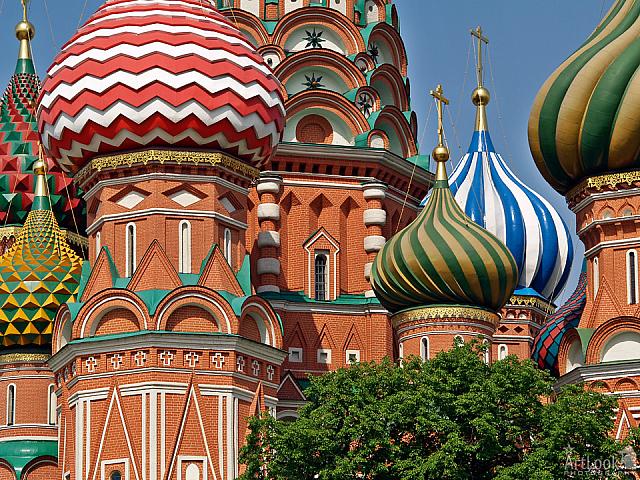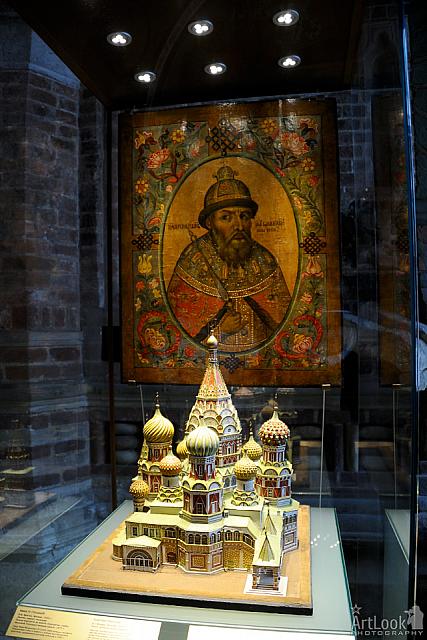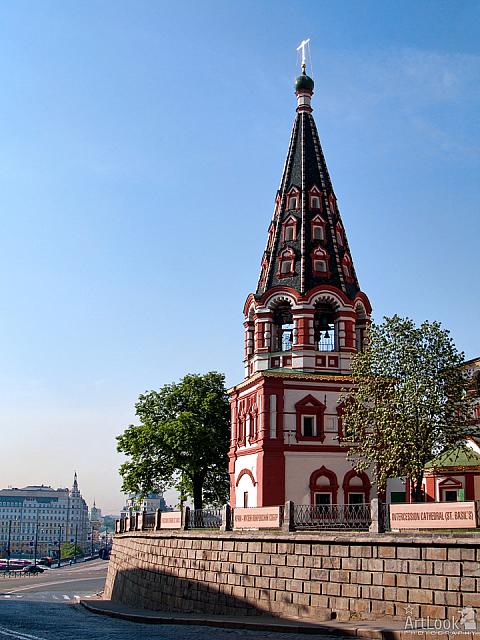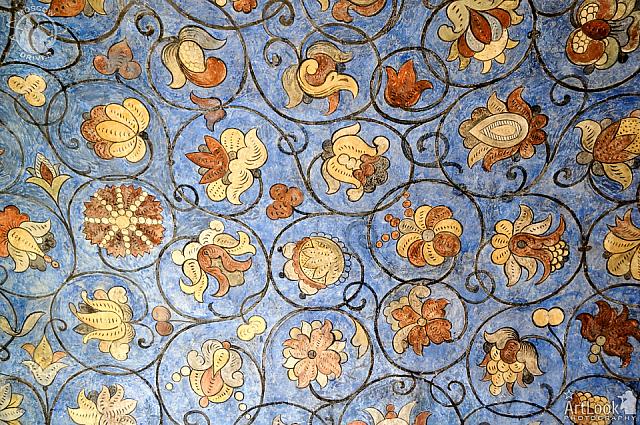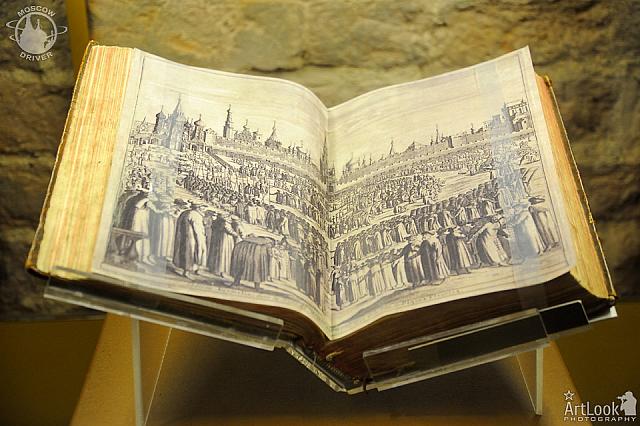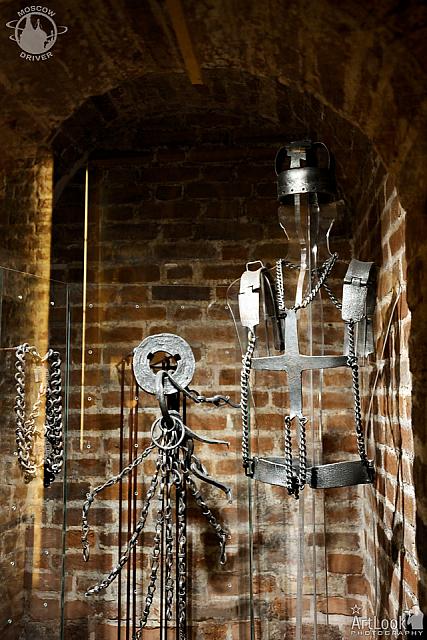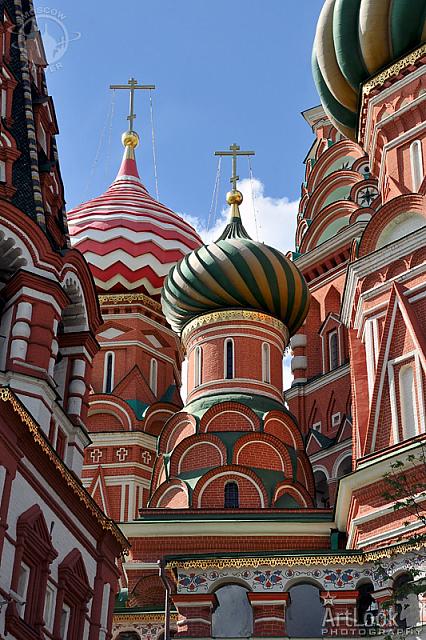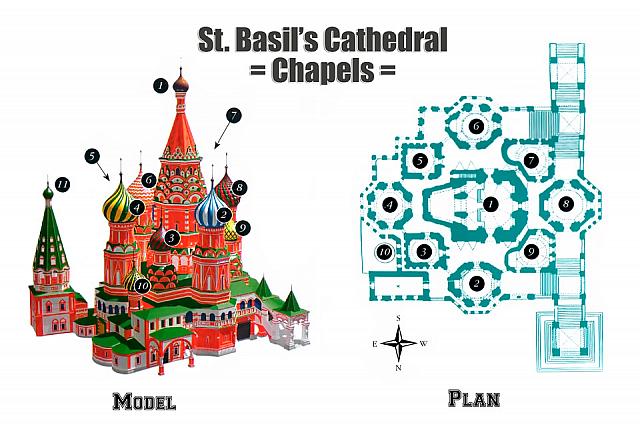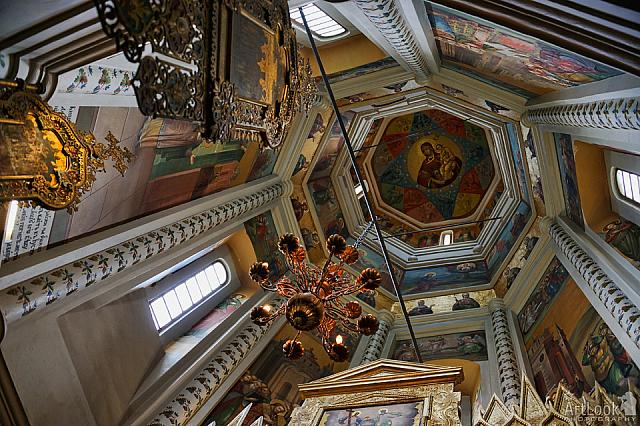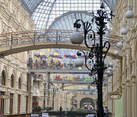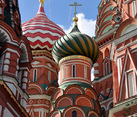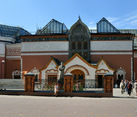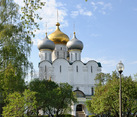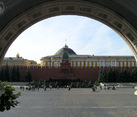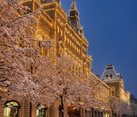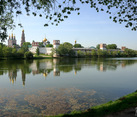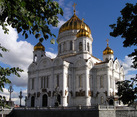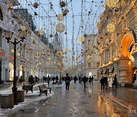St. Basil's Cathedral
The cathedral of St. Basil with its unusual combination of domes, artful forms and overall harmony is a superb, unmatched masterpiece of Russian architecture, and probably the most celebrated and mysterious temple in Russia. Its real name is the Cathedral of the Intercession of the Holy Virgin (Pokrovsky Sobor), Which is on the Moat (the Aloisius Moat, running along the Kremlin wall nearby, was filled in the early 1800s), but the temple is better known as the Cathedral of St. Basil the Blessed, or St. Basil’s. The central ribbed roof is surrounded by eight onions, none of them the same as the others, signifying eight Chapels, each dedicated to its own saint or event, connected by galleries.In contrast to its fascinating exterior, the cathedral is disappointingly small inside. There is not enough room for many people to pray at the same time. The cramped rooms, low gallery vaults and narrow passageways seem more appropriate for a Medieval home, not a place of worship. We can assume that the cathedral was originally intended to impress with its exterior appearance only.
History
St. Basil’s Cathedral was built in 1555-1561 under orders from Ivan the Terrible with the blessing of Metropolitan Macarius in honor of the Russian conquest of Kazan and the Kazan Khanate in 1552. The full and final defeat of Tartar troops on their home turf was an inspiration to all Russian people.The Battle of Kazan was compared to the Battle of Kulikovo Polye, which had ended centuries of Tartar Mongolian rule in Russia. Upon his return from Kazan, the Czar threw a sumptuous feast in the Kremlin that went on for several days with lavish gifts for everyone.
The original wooden Cathedral of the Intercession of the Holy Virgin with seven Chapels was consecrated on 1 October 1554. Some of the Chapels were dedicated to the saints whose holidays had coincided with Kazan campaign highlights: August 30 (according to the old calendar), when the Russians had defeated a large Tartar troop led by Prince Epancha, is the day of three Constantinople Patriarchs: Alexander, John and Paul, as well as St. Alexander of Svir. On September 30, the day dedicated to Gregory, the enlightener of Armenia, the Russians had captured a part of the Kazan fortress wall and the Arsk tower. Kazan was stormed and conquered on October 2, Sts. Cyprian and Justina Day These dedication and the choice of location for the new temple continued a tradition started by Vasily III, Ivan the Terrible’s father, who had ordered a Cathedral built by the moat to commemorate his conquest of Smolensk, dedicating its altars to the saints whose name days coincided with the day of his victory over Smolensk. The older church had burned down during one of Moscow’s many fires.
Another altar in the new Cathedral was consecrated in honor of St. Varlaam of Khutyn, possibly in memory of Vasily III who had, at the end of his life, taken monastic vows as was the custom for Russian rulers at the time. Basil’s monastic name was Varlaam. The altar in the easterly Chapel was dedicated to the Holy Trinity, while the main altar was dedicated to the Holy Virgin’s patronage over all Christians. Virgin Mary is specially worshipped in the Russian Orthodox tradition as a celestial protector. On Intercession of the Holy Virgin Day, Kazan had stood besieged, and soon fell. The westerly Chapel was dedicated to the Entry of Jesus into Jerusalem. This holiday was marked with a “donkey procession” (described in the Red Square chapter). Before the Cathedral of the Intercession was built, the procession had always stayed inside the Kremlin walls. It is possible that the Czar had had a change of the procession itinerary in mind when he ordered the Cathedral built. From then on, the procession would walk from the Kremlin to the new temple.
Ivan the Terrible soon ordered the Cathedral rebuilt in stone. According to historical evidence, the architects “Barma and Postnik Yakovlev,” hired to design the stone Cathedral, had originally designed it with nine altars, and here is why.Soon before the construction began, the Czar had received visitors from the town of Khlynov (Viatka), bringing the tidings of a new miracle-working icon of St. Nicholas Velikoretsky. The icon had survived a devastating church fire with only minor damage, and the envoys from Viatka were seeking the Czar’s permission to bring it to Moscow for restoration. The Czar had prayed to St. Nicholas repeatedly during his Kazan campaign, so the appearance of a new miraculous St. Nicholas icon was conceived as the saint’s blessing for what the Czar had done, instituting Orthodox Christianity in the Kazan lands and annexing them to Muscovy. Ivan the Terrible ordered the icon delivered to Moscow immediately, and decided to dedicate the ninth Chapel of his new Cathedral to St. Nicholas. The icon was shipped by riverboat across the Kazan lands as a semblance of the Procession of the Cross across the previously pagan Tartar Khanate, now conquered by Russia.
When the Cathedral was completed, it was painted in the brickwork pattern. In actual fact, the temple was built in brick in the first place; only its foundation, basement, and some decorations were made in white stone. A standalone bell tower was built at the Cathedral’s southeastern corner at around the same time.In 1588, during the reign of Feodor, another church was built here on the grave of Basil the Blessed, a street prophet worshipped in Moscow at the time, who had died in 1557. Unlike the other Chapels of the Cathedral of the Intercession, this church held daily sermons, so it wasn’t long before parishioners started calling the whole-cathedral St. Basil’s.
The cathedral underwent some major remodeling at the end of the 17th century: the outdoor wraparound gallery was covered with vaults; ribbed awnings were built over the entrances, and a northerly Chapel was added to the Basil the Blessed Church as a second level, dedicated to Theodosia the Virgin. Soon another church was built next to St. Basil’s, dedicated to another worshipped “God’s Fool,” named John but better known under the nickname “Big Fool’s Cap,” buried here in 1589. More remodeling was done to make room for the altars of several other churches that had stood in Red Square, but were pulled down due to disrepair. The floral ornaments on the vestibules and porches were painted around the same time.Many of the “guest” altars were “retired” during the reign of Catherine II in the 18th century, and the Cathedral was repainted according to the artistic fashion of the epoch.
The cathedral acquired its present colorful look after a succession of restorations in the 20thcentury, which restored the temple to its 16th-17th century look. The motley onion domes were painted the way they were in the 19th century.
We will just mention one of the many legends that surround St. Basil’s Church. It is claimed that Ivan the Terrible ordered the architects of St. Basil’s blinded so that they never build an amazing temple like this again. In fact, similar legends exist in many cultures about their own treasured masterpieces. Our only source on this is the travelogue of a German traveler named Adam Olearius who visited Moscow in the 17th century. No Russian chroniclers ever mentioned the blinding.Holy Relics at St. Basil’s
A Moscow street prophet, Basil the Blessed, was buried by the Cathedral’s northeastern wall in 1557. According to legend, Basil was revered and feared by Ivan the Terrible himself as a Holy Fool (Yourodivy).
Such person was someone who had voluntarily rejected earthly comforts and pleasures. Under the guise of insanity, these people defied all shame and decency. (Usually, these “God’s Fools” were quite sane, sensible — or at least extremely brave — people). A beatific person would affront and offend other people by wallowing in the mud, walking around naked, and shouting insults. At the same time, God’s Fools were under the special unspoken patronage of the Church. Like Basil, many of them were posthumously canonized as saints. Like court jesters, yurodivye freaks were “entitled” to say things to the rulers for which a regular person would face immediate punishment by death.
Originally, Basil the Blessed had had nothing to do with the Cathedral. He was simply buried here while the temple was still under construction, and later another church was built on the grave, adjacent to the Cathedral. But today most people apply the name St. Basil’s to the whole temple, and have no idea that the Cathedral actually has a different name.
St. Basil was born in 1469 in Elokhovo near Moscow, and was trained to be a shoemaker. Basil displayed his prophetic gift quite early. He became a yurodivyi at age 16, leading an ascetic life and teaching people about religion and morality. Basil lived a very long life. The 1588 Church Assembly canonized Basil as a saint, while Tsar Feodor ordered a silver gold-plated shrine encrusted with gems and pearls erected above the grave of a man who had never worn any clothes and had begged for food all his life.
In the southeasterly wing of the Cathedral, which is closed to general public, the relics of another yurodivyi lie under a bushel. St. John, nicknamed “Big Fool’s Cap,” died in 1589. John walked around barefoot all year, wearing nothing but a cloak with a large hood (hence his nickname). John wore long hair, a heavy copper cross on his chest, fetters, copper rings on his fingers, and an iron cap. He would publicly expose the sins of Boris Godunov before the latter became Czar, and predicted Godunov’s bitter end. John was canonized in 1672. Originally, a precious silver-plated shrine stood on his grave on which lay his fetters, weighing around 40 kg, and his iron cap. The shrine was requisitioned following the 1917 Bolshevik coup, but the fetters and the cap are on display in the Cathedral museum. The fresco icon The Sign of God’s Mother, sized 2.84 by 2.84 m, was painted specially for the cathedral in the early 18th century. The icon, placed outside on the easterly wall of the Holy Trinity Chapel, was worshipped and considered miraculous.A modified copy on wood was made of this icon in the 1780s, with a slightly different lineup of saints at the edges. This copy used to hang above the entrance to the St. Basil the Blessed Church. It is now on display on the ground floor.
Another large facade icon, The Intercession of Our Lady, sized 2.6 by 3.8 m, was painted in the 1780s. It is now on the southerly wall of the Cathedral belfry.
Chapels of St. Basil’s
One architectural peculiarity of St. Basil’s is that it consists of nine individual Chapels sharing a foundation. Four tall pillar-like Chapels are centered around the main Chapel, facing east, west, north and south, with four lower Chapels in between.The cathedral has two roofed porches, but the only functioning entry for visitors is through St. Basil’s Church. Its existing iconostasis and murals date back to the late 19th - early 20th centuries. The precious shrine over St. Basil’s grave was looted by Polish soldiers during the Time of Troubles period; the existing shrine was made in 1896, displaying scenes from the saint’s life: Miracle on the Water and Miracle of the Putting Out of the Novgorod Fire. The first scene refers to a legend about how St. Basil saved a Persian ship in the Caspian Sea. During a horrible storm, Orthodox Christians, who were on the ship along with Persians, were praying for salvation. Suddenly they saw a naked man walking on the water, who pacified the sea. When the travelers came to Moscow, they recognized Basil the Blessed as their savior. According to another legend, the Czar offered Basil a goblet of wine three times, and Basil would dump the wine on the ground every time. When the Czar demanded an explanation, Basil claimed he had just put out a great fire in Novgorod. Some time later, Novgorodians confirmed they had seen a naked man who put out a major fire in their town with water.
There is another — more gruesome — tale frequently associated with the images of St. Basil. One of Basil’s rich worshippers once convinced him to accept an expensive fur coat as a gift. Some thieves decided to cheat Basil out of his fur coat. One of them feigned death, while the others asked Basil to donate something for their friend’s funeral. Basil covered the alleged dead body with his fur coat, saying: “Be dead now for your lies.” When Basil left, the thieves lifted up the coat and saw that their co-conspirator was, indeed, dead.
St. Basil’s Church did not have a passage to the main temple until the 19th century. This is now the public entry to the Cathedral basement. The niches in the basement used to be depositories where a part of the royal treasury was stored. Centuries ago, locals also stored their valuables here. The Cathedral’s thick stone walls offered reliable protection from fires, which happened quite frequently in Moscow. It was not easy to get into the basement, which has no windows. The only access was a narrow staircase leading down from the second level. This is the staircase visitors use to climb to the second-level Chapels and walk around the cathedral through a wraparound indoor gallery. Admiring the murals, one should bear in mint I that they were painted at different — relatively recent — times. The original painting was plain brickwork.1. The Chapel of the Intercession of the Holy Virgin (main Chapel)
This Chapel was one of the earliest architectural experiments that placed two octagons sharing a ribbed roof on top of a square. This started a whole new trend in architecture. However, a tall structure like this with a small base plate is very difficult to heat, and cannot be used by many people praying at the same time, which is one of the reasons why very few churches like this were ever built.
The iconostasis now standing inside the Chapel of the Intercession of the Holy Virgin was transferred here in 1770 from the Chernigov Church inside the Kremlin after it was divested of its church status. The old iconostasis was sold to the village of Svistukha in the Kaliazin region for 70 rubles. The central Chapel icon — The Intercession of the Holy Virgin — dates back to that time, as do the other icons in this Chapel, including several images of Basil the Blessed.
The interior of the Chapel is decorated with restored 16th century murals. High above (the Chapel is 47.5 m tall), under the rotunda windows, the builders had inscribed the date when the Cathedral was completed: 29 June (Julian calendar) 1561. The southerly wall displays some 19th century icon art, and there is a fragment of an 18th century mural in the southwesterly corner.
2. The Chapel of the Holy Martyrs Cyprian and Justina (northern Chapel)
The iconostasis of the Chapel of Sts. Cyprian and Justina was created in 1784-1786, and its icons were painted at the same time. The icons in the bottom row tell the story of the two days of the Creation, when the Lord created water and the sky.
The murals display scenes of suffering from the life of Sts. Cyprian and Justina (second row), and Sts. Adrian and Natalia (first row). The images of the latter two martyrs were painted in 1786, when a certain Natalia Khrushcheva, a wealthy parishioner, donated money for repair and, in return, asked for the Chapel to be rededicated in her honor. Her wish was granted, but the original dedication was eventually restored. An image of Virgin Mary looks down from the Chapel dome.This Chapel houses two metal church gonfalons. One, bearing the image of Our Savior Facing Sergius of Radonezh and Varlaam of Khutyn, was introduced in 1913 in celebration of the 300th anniversary of the House of Romanov. The other, displaying the Intercession of the Holy Virgin with the namesake saints of members of the royal family, was placed in the Chapel in 1904 on the occasion of the birth of Prince Alexius.
3. The Chapel of the Three Patriarchs of Constantinople: Alexander, John and Paul the New (northeastern Chapel)
The five-level iconostasis at the Three Patriarchs’ Chapel was created in 1842-1849. In 1849, this Chapel was rededicated to St. Gregory of Armenia, which explains why the murals in the top row represent the life of the three Patriarchs of Constantinople, while the murals in the bottom row display scenes from the life of St. Gregory, the Enlightener of Armenia.
4. The Chapel of St. Nicholas (southern Chapel)
The original iconostasis of the Chapel of St. Nicholas burned down in the 1737 fire; the existing one was crafted in 1786. The Chapel icons date back to the same time, including the main icon of St. Nicholas of Velikoretskoe on the southern door of the iconostasis.
The 19th century murals illustrate a story from a Nikon-era chronicle about how the Icon of St. Nicholas of Velikoretskoe was brought to Moscow. The text on the northwestern wall tells the story of how the icon was received.
Most of the floors in this Chapel are covered with 18th century white stone slabs, but on one part of the floor, the slabs have been intentionally removed to expose the original oak parquet.
5. The Chapel of the Holy Trinity (eastern Chapel)
The iconostasis at the Holy Trinity Chapel has been restored in its 16th century look, incorporating coeval icons by Moscow and Novgorod painters. The main icon — 16th century Icon of the Holy Trinity — is one of the oldest existing icons at the Cathedral of the Intercession.
The architecture and decorations in tins Chapel were also restored in their original 16th century look.
6. The Chapel of the Entry of Our Lord into Jerusalem (western Chapel)
The iconostasis of the Chapel of the I\n try of Our Lord into Jerusalem was moved here in 1770 from the Kremlin Church of St. Alexander Nevsky, abolished three years earlier. The majority of the icons in this Chapel were painted in the 18th century, but there are two 17th century icons here that are quite unique. One is the Icon of St. Alexander Nevsky with 33 scenes from his life, showing the holy and virtuous prince in his monastic vestments. Shortly before his death, Prince Alexander Nevsky took monastic vows and the name Alexius. The second icon, depicting the Entry of Our Lord into Jerusalem, may have been moved here from another major church in the Kremlin.
The interior of this Chapel is exactly the same as it was in the 17th century.
7. The Chapel of St. Alexander of Svir (southeastern Chapel)
At the Chapel of St. Alexander of Svir, the conjoined iconostasis has been restored in its original 16th century look, featuring an assortment of 16th and 17th century icons. The dominant image is an early 18th century icon of St. Alexander of Svir. Two sewed 18th century shrouds hang underneath the icon row.
The walls in this Chapel are painted to resemble brickwork, the same way they were in the 16th century.
8. The Chapel of St. Varlaam of Khutyn (southwestern Chapel)
The two-level conjoined iconostasis of the Chapel of St. Varlaam of Khutyn has been restored in its 16th century look, consisting of 16th-18th century icons, two of them completely unique: the 16th century icons of St. Varlaam of Khutyn and Vision of Sexton Tarasius.
The latter icon illustrates a legend about how the late St. Varlaam appeared before Tarasius, the sexton at the Khutyn Monastery, to predict the fire and famine to be visited on Novgorod for its sins in 1508. The saint also predicted a great flood, but the flood never happened thanks to St. Varlaam’s intervention before the Lord.
The whitewashed walls look exactly the same as they did in the 17th century.
9. The Chapel of the Holy Martyr Gregory, Bishop and Enlightener of Armenia (northwestern Chapel)
The restored conjoined iconostasis in the Chapel of St. Gregory of Armenia houses several 17th century icons by different painters, as well as a 16th century icon of John the Merciful. In 1788, a wealthy parishioner named Ivan Kislinsky had the Chapel rededicated in the name of St. John the Merciful, the Patriarch of Alexandria.
Cathedral Symbolism
It is not easy to unravel all the symbolism built by the old architects into a temple erected so many centuries ago, but we can guess a few things.
The four tall pillar Chapels around the central temple face the four parts of the world, while the four lower Chapels are positioned symmetrically in between. This suggests that the old architects designed the cathedral as two squares, one inside the other with a 45 degree shift. This shape forms an eight-pronged star, one of the symbols of the Holy Virgin usually displayed on her robes. The same star is repeated in the layout of the octagonal tent-like roof of the Chapel of the Intercession. It is believed that the nine-dome temple is in itself a symbol of Our Lady as a celestial patron of the Russian Orthodox Church. The cathedral is filled with Virgin Mary symbolism.
Another set of symbolism is linked to the concept of Moscow as “The Third Rome” and heir to the former hubs of Orthodox Christianity, which gained circulation during the reign of Ivan the Terrible. Moscow was to become an agglomeration of sanctity, saints and sacred objects. The Cathedral of the Intercession with its many onion domed Chapels that look like a small town in its own right was conceived as a symbol of the earthly and heavenly city of Jerusalem.
Previous
Read Square – Russia’s Heart
Next
Novodevichy Cemetery
About Me in Short

My name's Arthur Lookyanov, I'm a private tour guide, personal driver and photographer in Moscow, Russia. I work in my business and run my website Moscow-Driver.com from 2002. Read more about me and my services, check out testimonials of my former business and travel clients from all over the World, hit me up on Twitter or other social websites. I hope that you will like my photos as well.
See you in Moscow!

